
FUE hair transplant scarless hair transplant and direct extraction
The FUE (Follicular Unit Extraction) technique has revolutionised the world of hair surgery by eliminating the main drawback of previous hair transplant techniques: the linear scar. With FUE, the extraction of the hair follicule no longer required to bear a lifelong a scar as stigma of the surgery (even if the scar of a FUT is thin). This is the so-called "Scarless" technique. This method uses punches (cylindrical blades) to isolate the hair root directly in the patient's scalp, and extract the follicles that produce the hair. The size of these punches (0.7 to 0.9 mm in diameter) is so small that the skin closes in a few hours and almost no visible traces remain on the skin.
FUE
Prices
About
The FUE hair transplant technique is known for its less invasive approach compared to FUT. Its main advantage lies in the follicular extraction method that avoids any linear scarring, offering a more aesthetic final appearance, without scarring in the donor area - at the back of the head.
The use of medical-grade 4 titanium micro-punches allows for such precise extractions in the donor area that the resulting micro-scars are almost undetectable to the naked eye. This makes it possible to wear very short hair after the procedure without visible scars.
For the transplantation area - called the "recipient" area, the method uses Custom Blade procedures and/or sapphire blades. Tiny incisions made with custom Blades or Sapphire Blades allow for extremely precise placement of hair follicles. This precision promotes high hair density while maintaining a very natural appearance.
FUE allows for a level of finesse and naturalness through the combined use of punch techniques for the donor area (biocompatible titanium punch of 0.7 to 0.9 mm, and "custom" and "Sapphire" blades, which make flat, thin, and close incisions, for a natural and dense result in the recipient area.
It is important to note that regardless of the chosen hair transplantation method, micro-scars will always remain, including with FUE. As a patient, it is crucial to distinguish between marketing promises and clinical reality: the total absence of scars is not possible.
Indications for FUE Hair Transplant
FUE hair transplantation is mainly recommended for the following cases:
- Male pattern baldness.
- Traction alopecia.
- Aesthetic improvement of the scalp.
Medical Approach
It is essential to understand that:
- Hair transplantation, although effective, is not a curative solution against hair loss and does not prevent its future progression.
- Medical treatments, such as growth phase stimulants (Minoxidil, laser treatments) or 5 alpha-reductase enzyme inhibitors (Propecia, Keratene Serum, Saw Palmetto), can slow down or even stop androgenic alopecia.
ANESTHESIA
FUE hair transplant procedures are systematically performed under local anesthesia. it is an outpatient procedure. Patients do not sleep in the clinic.
Duration of the procedure:
This surgery will last up to 12 hours and sometimes extends over several days depending on the techniques and the type of hair.
Results of an FUE
You can only fully benefit from the results of a transplant after 12 to 15 months. This is the time necessary for all the follicles to return to their active phase and start producing sufficiently thick and healthy hair. In general, the results of a well-performed hair transplant are natural and can go so far as to completely erase baldness
After FUE surgery
After 15 days, the visible traces of the surgery are almost gone.
Swelling can occur between the 3rd and 5th day. The transplanted hair falls after 1 to 2 months and 10 to 15% grows back from the 3rd month each month.
FAQ
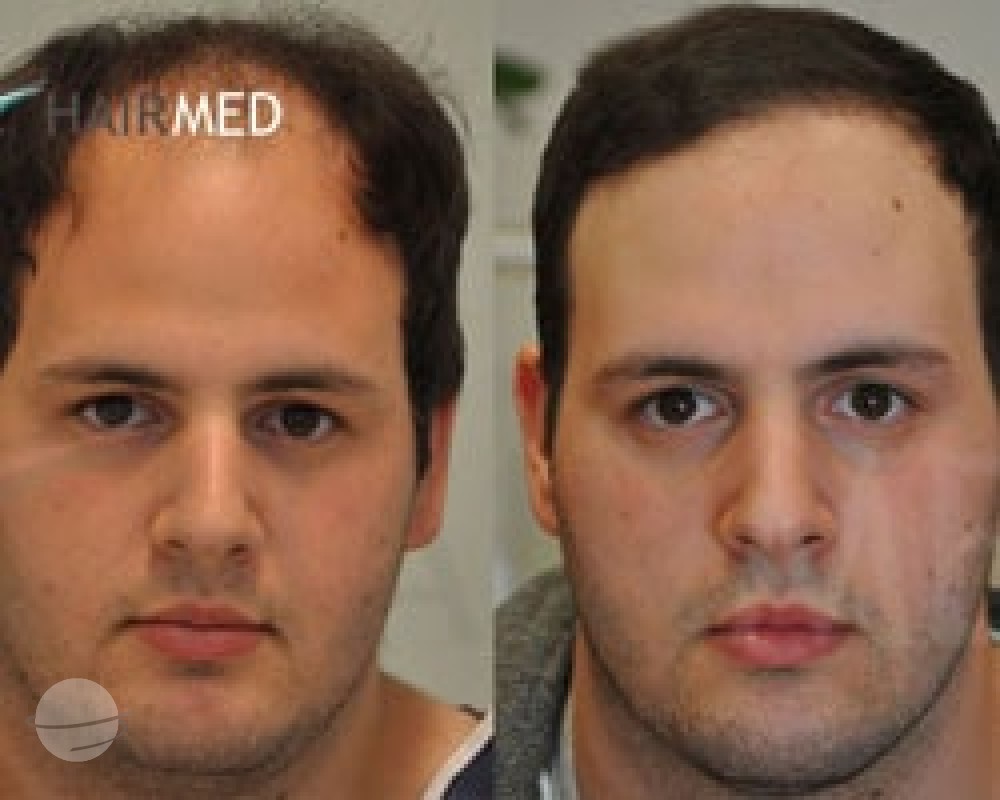
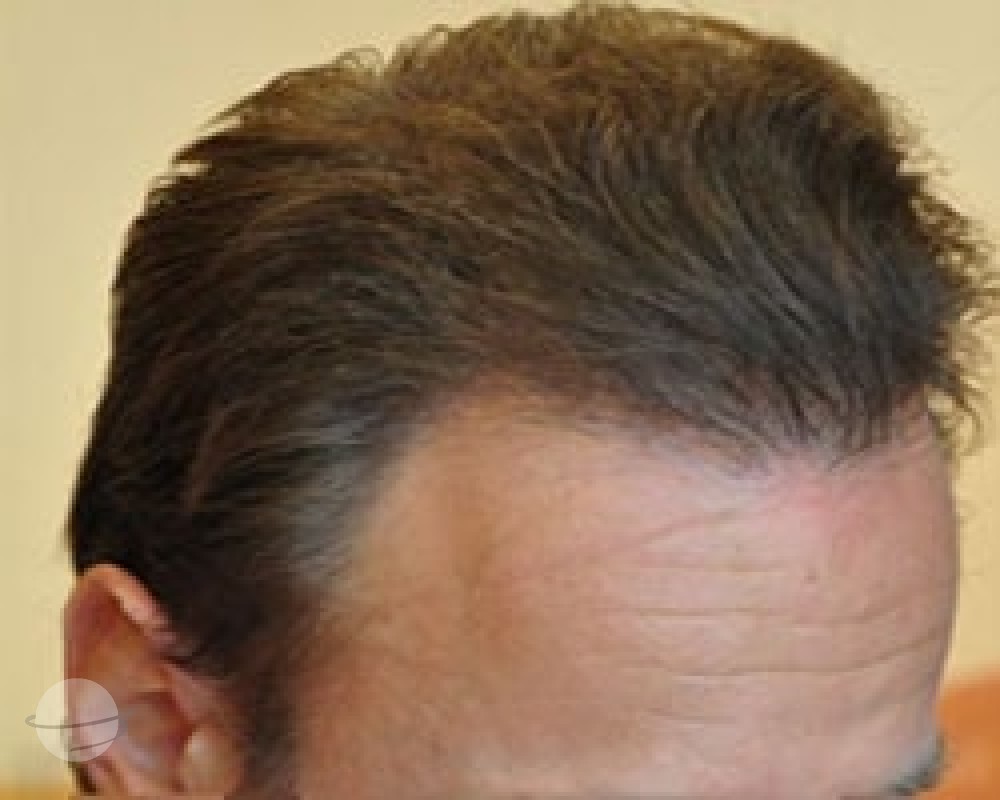
AFRO FUE
Prices
About
FUE hair transplantation is known to be less invasive than FUT. Its main advantage is the method of follicle extraction, which leaves no linear scars.
FUE AFRO is specific due to the curved nature of the bulbs inside the skin, making them particularly difficult to extract.
Characteristics of Afro Hair
Afro hair has characteristics that make it different from other hair types. It has a spiral structure, is thicker, curly, and tends to be more fragile. These characteristics pose challenges during hair transplantation.
Reality of Global FUE Afro Offer
Very few practitioners worldwide master this practice. The difference in Afro hair in FUE is mainly during extraction. Extracting the entire bulb without damaging it is the main challenge of FUE hair transplantation on Afro hair.
Specific Technique: Afro FUE
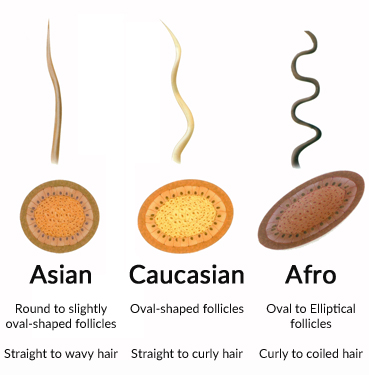
Photo credit: https://www.belgraviacentre.com/blog/hair-types-and-race-differences
Afro FUE is a hair transplantation technique specially adapted to Afro hair. It involves the individual extraction of hair follicles from the donor area and their transplantation into the target areas. However, due to the curvature and structure of Afro hair, this procedure can be more complex and require additional expertise.
Ethnic FUE or Afro FUE Method
Each method for obtaining viable grafts varies depending on the practitioner. It is the procedure for extracting and isolating grafts in the donor area that changes. Some practitioners use a 3-step isolation or wider punches and/or specific shapes.
For implantation, the method is the same:
The method involves such small incisions (thanks to "custom blades" and "Sapphire" blades) that the placement of hair follicles is much more precise, allowing for high density while maintaining a very natural result. This result is achieved thanks to the use of "custom" and "Sapphire" blades, which allow for the finest and closest incisions in modern grafting.
For the donor area, the principle of FUE is the same. Isolations in the donor area are so small that they leave almost undetectable micro-scars to the naked eye, allowing for very short hair without visible traces of the intervention.
Attention: Regardless of the hair transplantation method, there will always be micro-scars, even for FUE. An "invisible" graft does not exist, so be vigilant as a patient between reality and marketing.
Differences Between Caucasian and Afro Hair
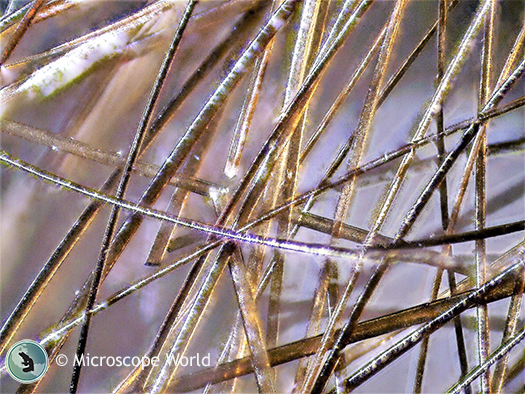
Caucasian hair under a microscope: Photo credit: https://www.microscopeworld.com/p-3349-hair-analysis-under-the-microscope.aspx
Straight hair allows the bulb to be isolated in the continuity of the hair with minimal risk of transection if the gesture is performed correctly. Isolating the hair bulb in the skin can be done quickly and continuously in the donor area without presenting particular risks, provided that an experienced practitioner performs the procedure.
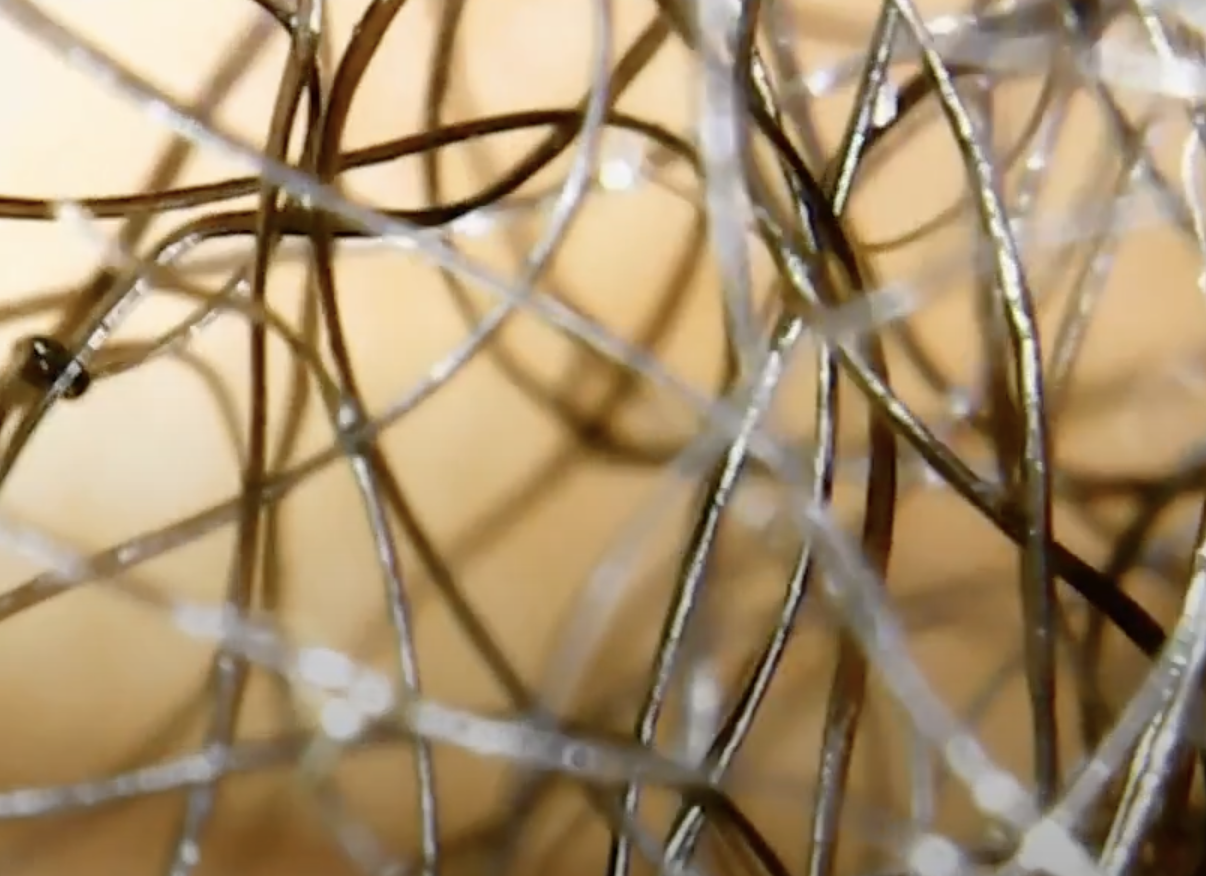
Afro hair under a microscope
Afro hair is already twisting, and the curvature is clear even under significant magnification. Comparing it with Caucasian hair helps better understand the difficulty of the bulb in the skin, which is also curved. Isolating an Afro bulb presents a significant risk of transection. Isolating the hair bulb in the skin cannot be done quickly and continuously throughout the donor area. Expertise and continuous monitoring during the isolation process are required.
Challenges of Afro FUE Hair Transplantation
Afro FUE hair transplantation presents several challenges, including:
- The curvature of hair follicles makes extraction more delicate and requires precise manipulation.
- The density of Afro hair may be lower, requiring careful planning to achieve natural and aesthetically satisfactory results.
- Healing may be different in individuals of African origin, requiring special attention to minimize the risks of complications.
Indications for Afro FUE or Ethnic FUE Hair Transplant
FUE hair transplant on Afro hair addresses the same conditions as standard FUE.
Mainly:
- Common male pattern baldness.
- Traction alopecia.
- Correction of physiological scalp issues.
Traction alopecia is much more common in female patients with Afro hair due to more frequent braiding.
Expected Results
Despite the challenges, Afro FUE hair transplantation can offer satisfactory results. Transplanted hair will naturally grow, creating a denser appearance and filling in bald areas. Results vary from person to person, but with careful planning and the expertise of a specialized surgeon, aesthetically pleasing results can be achieved.
Precautions to Take
To maximize the chances of success and minimize risks, it's important to take certain precautions during Afro FUE hair transplantation:
- Choose a surgeon specialized in Afro FUE hair transplants with proven experience.
- Discuss your expectations and desired outcomes in detail during the initial consultation.
- Ensure you have good overall health before undergoing the procedure.
- Follow the post-operative instructions provided by the surgeon to ensure optimal recovery.
Afro FUE hair transplantation is a complex procedure that requires specific expertise due to the unique characteristics of Afro hair. By selecting a qualified surgeon and taking necessary precautions, satisfactory and natural results can be achieved.
Recovery
There is no difference in recovery compared to standard FUE:
Crusts form and fall off after about 15 days.
After 15 days, traces of the procedure are almost gone.
Swelling may occur between the 3rd and 5th day.
Transplanted hair falls out after 1 to 2 months, and 10 to 15% regrows starting from the 3rd month, continuing each month.
Regrowth will extend over 12 to 15 months before achieving your final result.
FAQ
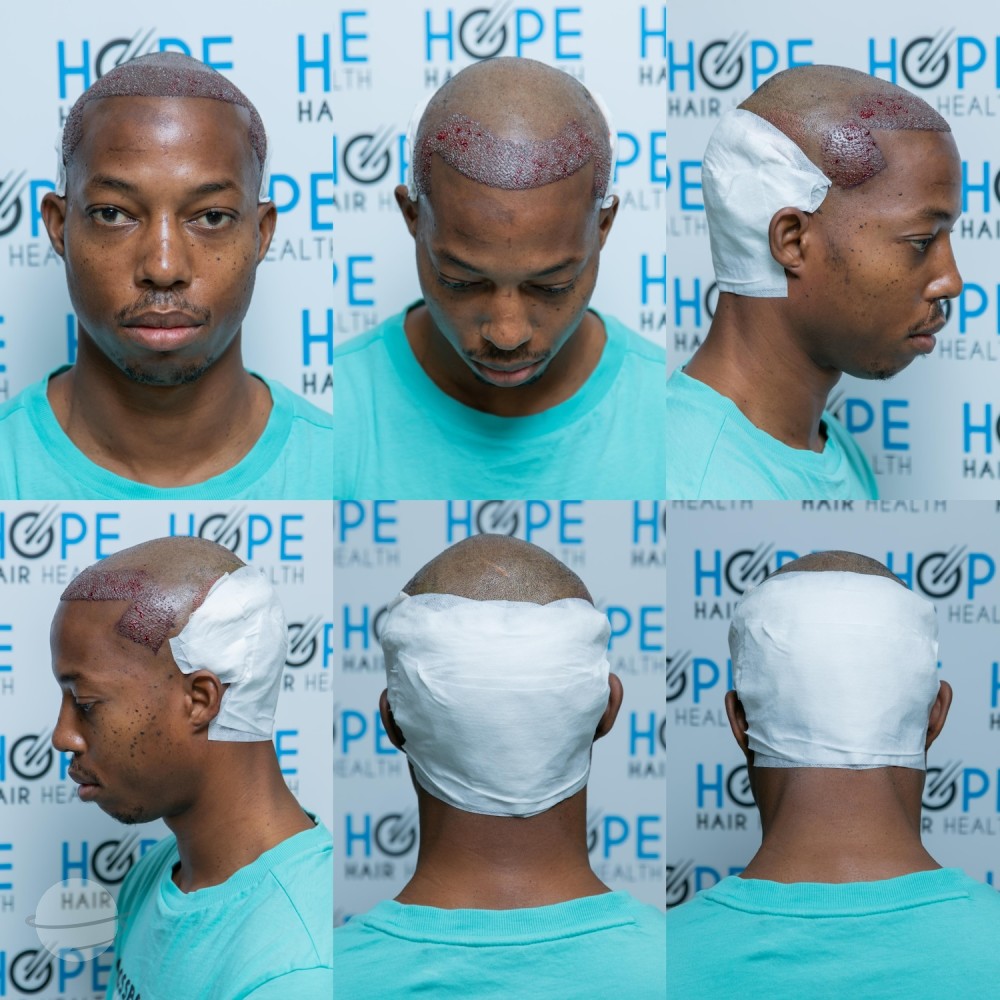
FUE Sapphire
Prices
About
Sapphire FUE refers to a FUE technique that uses a sapphire blade. Far from being a gemstone, this blade is specifically designed for hair transplants. Its main feature is its ability to stay sharp over time, thus facilitating precise incisions and minimizing effort throughout the procedure.
This property ensures a consistent quality of incisions throughout the procedure and improves the endurance of the surgical team. Indeed, the use of sapphire blades reduces manual fatigue, contributing to a more efficient and comfortable experience for professionals.
For patients, opting for Sapphire FUE guarantees continuity in the quality of incisions throughout the procedure, positively impacting all transplants. Incisions are crucial as they determine the angle, density, and overall design of the hair transplant, thus ensuring a superior and natural aesthetic result.
Sapphire FUE Transplant
The Sapphire FUE transplant is suitable for the same conditions as the standard FUE transplant, mainly including:
- Common male pattern baldness
- Traction alopecia
- Correction of physiological scalp conditions
However, this technique is particularly recommended for procedures requiring a large number of grafts. Thanks to their extreme precision, sapphire blades allow for very precise incisions, facilitating the creation of areas with high hair density.
Sapphire blades are used to work on areas that have been previously shaved or trimmed, allowing for optimal results with a large number of grafts, while maintaining precision throughout the procedure.
After care of Sapphire FUE Transplant
- Crusts form and disappear after 15 days.
- After 15 days, signs of the procedure are almost invisible.
- Swelling may occur between the 3rd and 5th day.
- Transplanted hair starts to fall out after 1 to 2 months, and 10 to 15% of it begins to regrow from the 3rd month, with monthly growth thereafter.
- Regrowth continues for 12 to 15 months before reaching the final result.
FAQ
FUE by Doctor
Prices
About
FUE Hair Transplantation: Technicians vs Doctors - What are the Differences?
FUE (Follicular Unit Extraction) hair transplantation can be performed either by technician teams or by doctors. Procedures conducted by technicians, sometimes without specific qualifications, often involve a standardized approach and may be limited in terms of expertise and customization.
On the other hand, transplants performed by doctors offer a higher level of expertise. These highly specialized professionals can handle more complex cases and combine various hair transplant techniques. Their multi-procedural approach allows for treating each case in a unique and tailored manner.
Doctors spend more time on each transplant, focusing on quality rather than quantity. They can spread a transplant over several days, ensuring meticulous and personalized attention, unlike one-day procedures carried out by technician teams.
FUE transplants performed by doctors are considered high-end, offering natural, long-lasting, and particularly satisfying results for patients seeking a superior solution for hair loss.
When it comes to hair transplantation, the issue of insurance differs between procedures performed by doctors and those carried out by technicians. Technicians must operate under a doctor's professional insurance, creating a grey area in the current market reality. The professional responsibility of some technician teams (though not all) can be challenging to discern for patients. This issue is non-existent when transplants are performed directly by doctors, thus providing greater clarity and security.
Insurance in Hair Transplantation: Doctors vs Technicians
When it comes to hair transplantation, the matter of insurance differs between procedures performed by doctors and those carried out by technicians. Technicians must operate under a doctor's professional insurance, creating a gray area in the current market reality. The professional liability of some technician teams (although not all) can be difficult for patients to discern. This issue is non-existent when transplants are performed directly by doctors, thus providing greater clarity and security.
FAQ